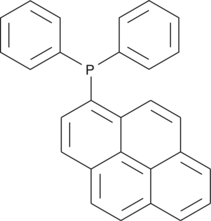Chemicals
Showing 18001–18150 of 41137 results
-
Dotriacontanoic acid methyl ester is a naturally occurring fatty acid methyl ester that has been found in the cuticular wax of P. abies needles.{42596} It has also been found in sediment samples from the Harney River in Florida and Lake Kivu in the East African rift valley.{38856,38863} [Matreya, LLC. Catalog No. 1275]
Brand:CaymanSKU:26728 - 10 mgAvailable on backorder
Dotriacontanoic acid methyl ester is a naturally occurring fatty acid methyl ester that has been found in the cuticular wax of P. abies needles.{42596} It has also been found in sediment samples from the Harney River in Florida and Lake Kivu in the East African rift valley.{38856,38863} [Matreya, LLC. Catalog No. 1275]
Brand:CaymanSKU:26728 - 100 mgAvailable on backorder
Dotriacontanoic acid methyl ester is a naturally occurring fatty acid methyl ester that has been found in the cuticular wax of P. abies needles.{42596} It has also been found in sediment samples from the Harney River in Florida and Lake Kivu in the East African rift valley.{38856,38863} [Matreya, LLC. Catalog No. 1275]
Brand:CaymanSKU:26728 - 25 mgAvailable on backorder
Dotriacontanoic acid methyl ester is a naturally occurring fatty acid methyl ester that has been found in the cuticular wax of P. abies needles.{42596} It has also been found in sediment samples from the Harney River in Florida and Lake Kivu in the East African rift valley.{38856,38863} [Matreya, LLC. Catalog No. 1275]
Brand:CaymanSKU:26728 - 50 mgAvailable on backorder
Dovitinib is a multi-kinase inhibitor.{47801} It inhibits the receptor tyrosine kinases FLT3, CSF1R, and c-Kit (IC50s = 1, 36, and 2 nM, respectively), as well as FGFR1, FGFR3, VEGFR1-3, PDFGRα, and PDGFRβ (IC50s = 8, 9, 10, 13, 8, 27, and 210 nM, respectively). Dovitinib inhibits proliferation of human multiple myeloma cell lines expressing mutant, but not wild-type, FGFR3 (IC50s = 90-550 and >2,500 nM, respectively). It decreases FGF-induced ERK1/2 phosphorylation and induces apoptosis in patient-derived multiple myeloma cells when used at a concentration of 500 nM. Dovitinib (3-300 mg/kg for eight days) inhibits bFGF-induced angiogenesis in a Matrigel™ plug assay in mice.{24514} It reduces tumor growth in KM12L4A colon, DU145 prostate, and MV4-11 acute myelogenous leukemia mouse xenograft models with ED50 values of 17, 23, and 3 mg/kg per day, respectively.
Brand:CaymanSKU:-Dovitinib is a multi-kinase inhibitor.{47801} It inhibits the receptor tyrosine kinases FLT3, CSF1R, and c-Kit (IC50s = 1, 36, and 2 nM, respectively), as well as FGFR1, FGFR3, VEGFR1-3, PDFGRα, and PDGFRβ (IC50s = 8, 9, 10, 13, 8, 27, and 210 nM, respectively). Dovitinib inhibits proliferation of human multiple myeloma cell lines expressing mutant, but not wild-type, FGFR3 (IC50s = 90-550 and >2,500 nM, respectively). It decreases FGF-induced ERK1/2 phosphorylation and induces apoptosis in patient-derived multiple myeloma cells when used at a concentration of 500 nM. Dovitinib (3-300 mg/kg for eight days) inhibits bFGF-induced angiogenesis in a Matrigel™ plug assay in mice.{24514} It reduces tumor growth in KM12L4A colon, DU145 prostate, and MV4-11 acute myelogenous leukemia mouse xenograft models with ED50 values of 17, 23, and 3 mg/kg per day, respectively.
Brand:CaymanSKU:-Dovitinib is a multi-kinase inhibitor.{47801} It inhibits the receptor tyrosine kinases FLT3, CSF1R, and c-Kit (IC50s = 1, 36, and 2 nM, respectively), as well as FGFR1, FGFR3, VEGFR1-3, PDFGRα, and PDGFRβ (IC50s = 8, 9, 10, 13, 8, 27, and 210 nM, respectively). Dovitinib inhibits proliferation of human multiple myeloma cell lines expressing mutant, but not wild-type, FGFR3 (IC50s = 90-550 and >2,500 nM, respectively). It decreases FGF-induced ERK1/2 phosphorylation and induces apoptosis in patient-derived multiple myeloma cells when used at a concentration of 500 nM. Dovitinib (3-300 mg/kg for eight days) inhibits bFGF-induced angiogenesis in a Matrigel™ plug assay in mice.{24514} It reduces tumor growth in KM12L4A colon, DU145 prostate, and MV4-11 acute myelogenous leukemia mouse xenograft models with ED50 values of 17, 23, and 3 mg/kg per day, respectively.
Brand:CaymanSKU:-Dovitinib is a multi-kinase inhibitor.{47801} It inhibits the receptor tyrosine kinases FLT3, CSF1R, and c-Kit (IC50s = 1, 36, and 2 nM, respectively), as well as FGFR1, FGFR3, VEGFR1-3, PDFGRα, and PDGFRβ (IC50s = 8, 9, 10, 13, 8, 27, and 210 nM, respectively). Dovitinib inhibits proliferation of human multiple myeloma cell lines expressing mutant, but not wild-type, FGFR3 (IC50s = 90-550 and >2,500 nM, respectively). It decreases FGF-induced ERK1/2 phosphorylation and induces apoptosis in patient-derived multiple myeloma cells when used at a concentration of 500 nM. Dovitinib (3-300 mg/kg for eight days) inhibits bFGF-induced angiogenesis in a Matrigel™ plug assay in mice.{24514} It reduces tumor growth in KM12L4A colon, DU145 prostate, and MV4-11 acute myelogenous leukemia mouse xenograft models with ED50 values of 17, 23, and 3 mg/kg per day, respectively.
Brand:CaymanSKU:-Dovitinib-d8 is intended for use as an internal standard for the quantification of dovitinib (Item No. 15220) by GC- or LC-MS. Dovitinib is a multi-kinase inhibitor.{47801} It inhibits the receptor tyrosine kinases FLT3, CSF1R, and c-Kit (IC50s = 1, 36, and 2 nM, respectively), as well as FGFR1, FGFR3, VEGFR1-3, PDFGRα, and PDGFRβ (IC50s = 8, 9, 10, 13, 8, 27, and 210 nM, respectively). Dovitinib inhibits proliferation of human multiple myeloma cell lines expressing mutant, but not wild-type, FGFR3 (IC50s = 90-550 and >2,500 nM, respectively). It decreases FGF-induced ERK1/2 phosphorylation and induces apoptosis in patient-derived multiple myeloma cells when used at a concentration of 500 nM. Dovitinib (3-300 mg/kg for eight days) inhibits bFGF-induced angiogenesis in a Matrigel™ plug assay in mice.{24514} It reduces tumor growth in KM12L4A colon, DU145 prostate, and MV4-11 acute myelogenous leukemia mouse xenograft models with ED50 values of 17, 23, and 3 mg/kg per day, respectively.
Brand:CaymanSKU:28706 - 1 mgAvailable on backorder
Doxapram is a central respiratory stimulant.{40470} It increases respiration and phrenic nerve activity in anesthetized cats at a dose of 1.0 mg/kg. Doxapram acts through carotid chemoreceptors, lacking activity in anesthetized cats following carotid denervation. Formulations containing doxapram have been used to increase respiration in patients with chronic pulmonary disease, respiratory depression induced by drug overdose, and to stimulate deep breathing post-anesthesia.
Brand:CaymanSKU:23794 - 10 mgAvailable on backorder
Doxapram is a central respiratory stimulant.{40470} It increases respiration and phrenic nerve activity in anesthetized cats at a dose of 1.0 mg/kg. Doxapram acts through carotid chemoreceptors, lacking activity in anesthetized cats following carotid denervation. Formulations containing doxapram have been used to increase respiration in patients with chronic pulmonary disease, respiratory depression induced by drug overdose, and to stimulate deep breathing post-anesthesia.
Brand:CaymanSKU:23794 - 25 mgAvailable on backorder
Doxapram is a central respiratory stimulant.{40470} It increases respiration and phrenic nerve activity in anesthetized cats at a dose of 1.0 mg/kg. Doxapram acts through carotid chemoreceptors, lacking activity in anesthetized cats following carotid denervation. Formulations containing doxapram have been used to increase respiration in patients with chronic pulmonary disease, respiratory depression induced by drug overdose, and to stimulate deep breathing post-anesthesia.
Brand:CaymanSKU:23794 - 5 mgAvailable on backorder
Doxazosin is a non-selective antagonist of α1-adrenergic receptors (α1-ARs; Kis = 3.16, 1, and 3.98 nM for α1A-, α1B-, and α1D-ARs, respectively).{18268} It inhibits norepinephrine-induced contractions in isolated rat aorta rings and human prostate strips with pA2 values of 8.8 and 8.2, respectively. Doxazosin inhibits phenylephrine-induced increases in blood pressure and prostatic pressure in anesthetized dogs (pA2 = 7.5 for both). Formulations containing doxazosin have been used in the treatment of benign prostatic hyperplasia and hypertension.
Brand:CaymanSKU:-Available on backorder
Doxazosin is a non-selective antagonist of α1-adrenergic receptors (α1-ARs; Kis = 3.16, 1, and 3.98 nM for α1A-, α1B-, and α1D-ARs, respectively).{18268} It inhibits norepinephrine-induced contractions in isolated rat aorta rings and human prostate strips with pA2 values of 8.8 and 8.2, respectively. Doxazosin inhibits phenylephrine-induced increases in blood pressure and prostatic pressure in anesthetized dogs (pA2 = 7.5 for both). Formulations containing doxazosin have been used in the treatment of benign prostatic hyperplasia and hypertension.
Brand:CaymanSKU:-Available on backorder
Doxazosin is a non-selective antagonist of α1-adrenergic receptors (α1-ARs; Kis = 3.16, 1, and 3.98 nM for α1A-, α1B-, and α1D-ARs, respectively).{18268} It inhibits norepinephrine-induced contractions in isolated rat aorta rings and human prostate strips with pA2 values of 8.8 and 8.2, respectively. Doxazosin inhibits phenylephrine-induced increases in blood pressure and prostatic pressure in anesthetized dogs (pA2 = 7.5 for both). Formulations containing doxazosin have been used in the treatment of benign prostatic hyperplasia and hypertension.
Brand:CaymanSKU:-Available on backorder
Doxazosin-d8 is intended for use as an internal standard for the quantification of doxazosin (Item No. 18633) by GC- or LC-MS. Doxazosin is a non-selective antagonist of α1-adrenergic receptors (α1-ARs; Kis = 3.16, 1, and 3.98 nM for α1A-, α1B-, and α1D-ARs, respectively).{18268} It inhibits norepinephrine-induced contractions in isolated rat aortic rings and human prostate strips with pA2 values of 8.8 and 8.2, respectively. Doxazosin inhibits phenylephrine-induced increases in blood pressure and prostatic pressure in anesthetized dogs (pA2 = 7.5 for both). Formulations containing doxazosin have been used in the treatment of benign prostatic hyperplasia and hypertension.
Brand:CaymanSKU:30979 - 1 mgAvailable on backorder
Doxazosin-d8 is intended for use as an internal standard for the quantification of doxazosin (Item No. 18633) by GC- or LC-MS. Doxazosin is a non-selective antagonist of α1-adrenergic receptors (α1-ARs; Kis = 3.16, 1, and 3.98 nM for α1A-, α1B-, and α1D-ARs, respectively).{18268} It inhibits norepinephrine-induced contractions in isolated rat aortic rings and human prostate strips with pA2 values of 8.8 and 8.2, respectively. Doxazosin inhibits phenylephrine-induced increases in blood pressure and prostatic pressure in anesthetized dogs (pA2 = 7.5 for both). Formulations containing doxazosin have been used in the treatment of benign prostatic hyperplasia and hypertension.
Brand:CaymanSKU:30979 - 500 µgAvailable on backorder
Doxepin is a tricyclic antidepressant that binds to the serotonin (5-HT) transporter (SERT) and norepinephrine transporter (NET; Kds = 68 and 29.5 nM, respectively).{22877} It is a histamine H1 receptor antagonist (Ki = 1.23 nM).{40358} Doxepin selectively binds to SERT and NET over the dopamine transporter (DAT; Kd = 12,100 nM) and inhibits histamine H1 over H2, H3, and H4 receptors (Kis = 170, 39,810, and 15,135 nM, respectively).{22877,40358} It also binds to the 5-HT2 receptor, as well as to muscarinic acetylcholine and α1-adrenergic receptors (α1-ARs; Kds = 27, 23, and 23.5 nM, respectively).{25803} Doxepin (10 mg/kg, i.p.) decreases allodynia and hyperalgesia in a mouse model of chronic constriction injury-induced neuropathic pain.{48874} It increases the distance traveled in the center of the open field test and reduces immobility time in the forced swim test in a mouse model of depression induced by chronic stress when administered orally at a dose of 15 mg/kg.{48875} Formulations containing doxepin have been used in the treatment of depression and insomnia.
Brand:CaymanSKU:-Doxepin is a tricyclic antidepressant that binds to the serotonin (5-HT) transporter (SERT) and norepinephrine transporter (NET; Kds = 68 and 29.5 nM, respectively).{22877} It is a histamine H1 receptor antagonist (Ki = 1.23 nM).{40358} Doxepin selectively binds to SERT and NET over the dopamine transporter (DAT; Kd = 12,100 nM) and inhibits histamine H1 over H2, H3, and H4 receptors (Kis = 170, 39,810, and 15,135 nM, respectively).{22877,40358} It also binds to the 5-HT2 receptor, as well as to muscarinic acetylcholine and α1-adrenergic receptors (α1-ARs; Kds = 27, 23, and 23.5 nM, respectively).{25803} Doxepin (10 mg/kg, i.p.) decreases allodynia and hyperalgesia in a mouse model of chronic constriction injury-induced neuropathic pain.{48874} It increases the distance traveled in the center of the open field test and reduces immobility time in the forced swim test in a mouse model of depression induced by chronic stress when administered orally at a dose of 15 mg/kg.{48875} Formulations containing doxepin have been used in the treatment of depression and insomnia.
Brand:CaymanSKU:-Doxofylline is a methylxanthine bronchodilator that has been examined in clinical trials involving patients with either bronchial asthma or chronic obstructive pulmonary disease.{30341} Its mechanism of action is related to its ability to inhibit phosphodiesterase activity and, thus, increase cAMP.{30343} Compared to other xanthine derivatives, which have direct arrhythmogenic effects, doxofylline demonstrates decreased affinity towards adenosine A1 and A2 receptors, does not interfere with calcium influx into cells, and does not antagonize the action of calcium-channel blockers.{30343,30342}
Brand:CaymanSKU:-Available on backorder
Doxofylline is a methylxanthine bronchodilator that has been examined in clinical trials involving patients with either bronchial asthma or chronic obstructive pulmonary disease.{30341} Its mechanism of action is related to its ability to inhibit phosphodiesterase activity and, thus, increase cAMP.{30343} Compared to other xanthine derivatives, which have direct arrhythmogenic effects, doxofylline demonstrates decreased affinity towards adenosine A1 and A2 receptors, does not interfere with calcium influx into cells, and does not antagonize the action of calcium-channel blockers.{30343,30342}
Brand:CaymanSKU:-Available on backorder
Doxofylline is a methylxanthine bronchodilator that has been examined in clinical trials involving patients with either bronchial asthma or chronic obstructive pulmonary disease.{30341} Its mechanism of action is related to its ability to inhibit phosphodiesterase activity and, thus, increase cAMP.{30343} Compared to other xanthine derivatives, which have direct arrhythmogenic effects, doxofylline demonstrates decreased affinity towards adenosine A1 and A2 receptors, does not interfere with calcium influx into cells, and does not antagonize the action of calcium-channel blockers.{30343,30342}
Brand:CaymanSKU:-Available on backorder
Doxofylline is a methylxanthine bronchodilator that has been examined in clinical trials involving patients with either bronchial asthma or chronic obstructive pulmonary disease.{30341} Its mechanism of action is related to its ability to inhibit phosphodiesterase activity and, thus, increase cAMP.{30343} Compared to other xanthine derivatives, which have direct arrhythmogenic effects, doxofylline demonstrates decreased affinity towards adenosine A1 and A2 receptors, does not interfere with calcium influx into cells, and does not antagonize the action of calcium-channel blockers.{30343,30342}
Brand:CaymanSKU:-Available on backorder
Doxorubicin is an anthracycline antitumor antibiotic that inhibits DNA topoisomerase II by inducing double-stranded DNA breaks.{22647} By intercalating within DNA, doxorubicin inhibits nucleic acid synthesis and induces apoptosis by inducing the accumulation of the p53 tumor suppressor protein.{17260}
Brand:CaymanSKU:-Doxorubicin is an anthracycline antitumor antibiotic that inhibits DNA topoisomerase II by inducing double-stranded DNA breaks.{22647} By intercalating within DNA, doxorubicin inhibits nucleic acid synthesis and induces apoptosis by inducing the accumulation of the p53 tumor suppressor protein.{17260}
Brand:CaymanSKU:-Doxorubicin is an anthracycline antitumor antibiotic that inhibits DNA topoisomerase II by inducing double-stranded DNA breaks.{22647} By intercalating within DNA, doxorubicin inhibits nucleic acid synthesis and induces apoptosis by inducing the accumulation of the p53 tumor suppressor protein.{17260}
Brand:CaymanSKU:-Doxorubicin is an anthracycline antitumor antibiotic that inhibits DNA topoisomerase II by inducing double-stranded DNA breaks.{22647} By intercalating within DNA, doxorubicin inhibits nucleic acid synthesis and induces apoptosis by inducing the accumulation of the p53 tumor suppressor protein.{17260}
Brand:CaymanSKU:-Doxorubicinone is a metabolite of the anthracycline antitumor antibiotic doxorubicin (Item No. 15007).{22647,37770} Doxorubicinone inhibits mitochondrial succinoxidase from bovine heart and reduces the mitochondrial inner membrane potential in rat heart and liver mitochondria in a concentration-dependent manner.{37771,37772} Doxorubicinone (40 μM) increases pentose phosphate pathway flux by 45% and reduces activity of glutathione peroxidase (GPx) and superoxide dismutase (SOD) by 17 and 60%, respectively, in human erythrocytes.{37773} It also induces cytotoxicity in patient-derived ovarian cancer colonies in a concentration-dependent manner.{37770}
Brand:CaymanSKU:21693 -Out of stock
Doxorubicinone is a metabolite of the anthracycline antitumor antibiotic doxorubicin (Item No. 15007).{22647,37770} Doxorubicinone inhibits mitochondrial succinoxidase from bovine heart and reduces the mitochondrial inner membrane potential in rat heart and liver mitochondria in a concentration-dependent manner.{37771,37772} Doxorubicinone (40 μM) increases pentose phosphate pathway flux by 45% and reduces activity of glutathione peroxidase (GPx) and superoxide dismutase (SOD) by 17 and 60%, respectively, in human erythrocytes.{37773} It also induces cytotoxicity in patient-derived ovarian cancer colonies in a concentration-dependent manner.{37770}
Brand:CaymanSKU:21693 -Out of stock
Doxorubicinone is a metabolite of the anthracycline antitumor antibiotic doxorubicin (Item No. 15007).{22647,37770} Doxorubicinone inhibits mitochondrial succinoxidase from bovine heart and reduces the mitochondrial inner membrane potential in rat heart and liver mitochondria in a concentration-dependent manner.{37771,37772} Doxorubicinone (40 μM) increases pentose phosphate pathway flux by 45% and reduces activity of glutathione peroxidase (GPx) and superoxide dismutase (SOD) by 17 and 60%, respectively, in human erythrocytes.{37773} It also induces cytotoxicity in patient-derived ovarian cancer colonies in a concentration-dependent manner.{37770}
Brand:CaymanSKU:21693 -Out of stock
Doxorubicinone is a metabolite of the anthracycline antitumor antibiotic doxorubicin (Item No. 15007).{22647,37770} Doxorubicinone inhibits mitochondrial succinoxidase from bovine heart and reduces the mitochondrial inner membrane potential in rat heart and liver mitochondria in a concentration-dependent manner.{37771,37772} Doxorubicinone (40 μM) increases pentose phosphate pathway flux by 45% and reduces activity of glutathione peroxidase (GPx) and superoxide dismutase (SOD) by 17 and 60%, respectively, in human erythrocytes.{37773} It also induces cytotoxicity in patient-derived ovarian cancer colonies in a concentration-dependent manner.{37770}
Brand:CaymanSKU:21693 -Out of stock
Doxycycline is a broad-spectrum tetracycline antibiotic.{42890,22938} It inhibits bacterial protein synthesis by binding to ribosomes.{22938,42891} Doxycycline also selectively inhibits human matrix metalloproteinase-8 (MMP-8) and MMP-13 over MMP-1 with 50, 60, and 5% inhibition, respectively, when used at a concentration of 30 μM.{22936} It can be used as a regulator for inducible gene expression systems where expression depends on either the presence (Tet-On) or absence (Tet-Off) of doxycycline.{22932,22934} Formulations containing doxycycline have been used in the treatment of bacterial infections and the prevention of malaria.
Brand:CaymanSKU:-Doxycycline is a broad-spectrum tetracycline antibiotic.{42890,22938} It inhibits bacterial protein synthesis by binding to ribosomes.{22938,42891} Doxycycline also selectively inhibits human matrix metalloproteinase-8 (MMP-8) and MMP-13 over MMP-1 with 50, 60, and 5% inhibition, respectively, when used at a concentration of 30 μM.{22936} It can be used as a regulator for inducible gene expression systems where expression depends on either the presence (Tet-On) or absence (Tet-Off) of doxycycline.{22932,22934} Formulations containing doxycycline have been used in the treatment of bacterial infections and the prevention of malaria.
Brand:CaymanSKU:-Doxycycline is a broad-spectrum tetracycline antibiotic.{42890,22938} It inhibits bacterial protein synthesis by binding to ribosomes.{22938,42891} Doxycycline also selectively inhibits human matrix metalloproteinase-8 (MMP-8) and MMP-13 over MMP-1 with 50, 60, and 5% inhibition, respectively, when used at a concentration of 30 μM.{22936} It can be used as a regulator for inducible gene expression systems where expression depends on either the presence (Tet-On) or absence (Tet-Off) of doxycycline.{22932,22934} Formulations containing doxycycline have been used in the treatment of bacterial infections and the prevention of malaria.
Brand:CaymanSKU:-Doxylamine (succinate) (Item No. 21826) is an analytical reference standard categorized as an antihistamine and hypnotic.{41040} Overdose of doxylamine (succinate) is common and has been associated with rhabdomyolysis.{41040,41039} This product is intended for research and forensic applications.
Brand:CaymanSKU:21826 -Out of stock
Doxylamine (succinate) (Item No. 21826) is an analytical reference standard categorized as an antihistamine and hypnotic.{41040} Overdose of doxylamine (succinate) is common and has been associated with rhabdomyolysis.{41040,41039} This product is intended for research and forensic applications.
Brand:CaymanSKU:21826 -Out of stock
Dp44mT is an iron chelator with antiproliferative effects.{38957} It inhibits in vitro proliferation of SK-N-MC neuroepithelioma, SK-Mel-28 melanoma, and MCF-7 breast cancer cells (IC50s = 30, 60, and 60 nM, respectively) but not of normal MRC-5 fibroblasts (IC50 = >25 µM). Dp44mT increases mobilization of 59Fe from SK-N-MC cells and M109 mouse lung carcinoma cells when used at concentrations of 25 and 1 µM, respectively. It dose-dependently increases apoptosis in M109 cells in vitro. Dp44mT (2.5 µM) increases expression of the metastasis suppressor protein NDRG1 in the DU145 and PC3 human prostate cancer cell lines to a greater degree than normal prostate epithelial cells (PrECs), while also increasing expression of the tumor suppressor protein PTEN in both DU145 cells and normal PrECs.{38958} Dp44mT also enhances cytotoxicity in several multidrug resistant human cancer cell lines following transport to lysosomes by P-glycoprotein.{38959} Dp44mT (0.4 mg/kg) inhibits M109 tumor growth in mice, reducing tumor weight to 47% of control.{38957} It also reduces tumor size and weight in an oral squamous cell carcinoma mouse xenograft model when administered at a dose of 0.5 mg/kg.{38960}
Brand:CaymanSKU:20936 -Out of stock
Dp44mT is an iron chelator with antiproliferative effects.{38957} It inhibits in vitro proliferation of SK-N-MC neuroepithelioma, SK-Mel-28 melanoma, and MCF-7 breast cancer cells (IC50s = 30, 60, and 60 nM, respectively) but not of normal MRC-5 fibroblasts (IC50 = >25 µM). Dp44mT increases mobilization of 59Fe from SK-N-MC cells and M109 mouse lung carcinoma cells when used at concentrations of 25 and 1 µM, respectively. It dose-dependently increases apoptosis in M109 cells in vitro. Dp44mT (2.5 µM) increases expression of the metastasis suppressor protein NDRG1 in the DU145 and PC3 human prostate cancer cell lines to a greater degree than normal prostate epithelial cells (PrECs), while also increasing expression of the tumor suppressor protein PTEN in both DU145 cells and normal PrECs.{38958} Dp44mT also enhances cytotoxicity in several multidrug resistant human cancer cell lines following transport to lysosomes by P-glycoprotein.{38959} Dp44mT (0.4 mg/kg) inhibits M109 tumor growth in mice, reducing tumor weight to 47% of control.{38957} It also reduces tumor size and weight in an oral squamous cell carcinoma mouse xenograft model when administered at a dose of 0.5 mg/kg.{38960}
Brand:CaymanSKU:20936 -Out of stock
Dp44mT is an iron chelator with antiproliferative effects.{38957} It inhibits in vitro proliferation of SK-N-MC neuroepithelioma, SK-Mel-28 melanoma, and MCF-7 breast cancer cells (IC50s = 30, 60, and 60 nM, respectively) but not of normal MRC-5 fibroblasts (IC50 = >25 µM). Dp44mT increases mobilization of 59Fe from SK-N-MC cells and M109 mouse lung carcinoma cells when used at concentrations of 25 and 1 µM, respectively. It dose-dependently increases apoptosis in M109 cells in vitro. Dp44mT (2.5 µM) increases expression of the metastasis suppressor protein NDRG1 in the DU145 and PC3 human prostate cancer cell lines to a greater degree than normal prostate epithelial cells (PrECs), while also increasing expression of the tumor suppressor protein PTEN in both DU145 cells and normal PrECs.{38958} Dp44mT also enhances cytotoxicity in several multidrug resistant human cancer cell lines following transport to lysosomes by P-glycoprotein.{38959} Dp44mT (0.4 mg/kg) inhibits M109 tumor growth in mice, reducing tumor weight to 47% of control.{38957} It also reduces tumor size and weight in an oral squamous cell carcinoma mouse xenograft model when administered at a dose of 0.5 mg/kg.{38960}
Brand:CaymanSKU:20936 -Out of stock
Dp44mT is an iron chelator with antiproliferative effects.{38957} It inhibits in vitro proliferation of SK-N-MC neuroepithelioma, SK-Mel-28 melanoma, and MCF-7 breast cancer cells (IC50s = 30, 60, and 60 nM, respectively) but not of normal MRC-5 fibroblasts (IC50 = >25 µM). Dp44mT increases mobilization of 59Fe from SK-N-MC cells and M109 mouse lung carcinoma cells when used at concentrations of 25 and 1 µM, respectively. It dose-dependently increases apoptosis in M109 cells in vitro. Dp44mT (2.5 µM) increases expression of the metastasis suppressor protein NDRG1 in the DU145 and PC3 human prostate cancer cell lines to a greater degree than normal prostate epithelial cells (PrECs), while also increasing expression of the tumor suppressor protein PTEN in both DU145 cells and normal PrECs.{38958} Dp44mT also enhances cytotoxicity in several multidrug resistant human cancer cell lines following transport to lysosomes by P-glycoprotein.{38959} Dp44mT (0.4 mg/kg) inhibits M109 tumor growth in mice, reducing tumor weight to 47% of control.{38957} It also reduces tumor size and weight in an oral squamous cell carcinoma mouse xenograft model when administered at a dose of 0.5 mg/kg.{38960}
Brand:CaymanSKU:20936 -Out of stock
Brand:CaymanSKU:29688 - 1 mgAvailable on backorder
Brand:CaymanSKU:29688 - 10 mgAvailable on backorder
Brand:CaymanSKU:29688 - 5 mgAvailable on backorder
DPPH, known formally as 2,2-diphenyl-1-picrylhydrazyl, is a cell-permeable, stable free radical that is commonly used to evaluate the ability of compounds to act as free radical scavengers or hydrogen donors and to measure the antioxidant activity of tissue extracts.{23729} The reaction of DPPH with an antioxidant or reducing compound produces the corresponding hydrazine DPPH2, which can be followed by color change from purple (absorbance at 515-528 nm) to yellow. The details and limitations of analysis have been recently reviewed.{23728,23727,23730}
Brand:CaymanSKU:-DPPH, known formally as 2,2-diphenyl-1-picrylhydrazyl, is a cell-permeable, stable free radical that is commonly used to evaluate the ability of compounds to act as free radical scavengers or hydrogen donors and to measure the antioxidant activity of tissue extracts.{23729} The reaction of DPPH with an antioxidant or reducing compound produces the corresponding hydrazine DPPH2, which can be followed by color change from purple (absorbance at 515-528 nm) to yellow. The details and limitations of analysis have been recently reviewed.{23728,23727,23730}
Brand:CaymanSKU:-DPPH, known formally as 2,2-diphenyl-1-picrylhydrazyl, is a cell-permeable, stable free radical that is commonly used to evaluate the ability of compounds to act as free radical scavengers or hydrogen donors and to measure the antioxidant activity of tissue extracts.{23729} The reaction of DPPH with an antioxidant or reducing compound produces the corresponding hydrazine DPPH2, which can be followed by color change from purple (absorbance at 515-528 nm) to yellow. The details and limitations of analysis have been recently reviewed.{23728,23727,23730}
Brand:CaymanSKU:-DPPI 1c is an inhibitor of dipeptidyl peptidase 4 (DPP-4; IC50 = 104 nM in an enzyme assay).{45967} It decreases plasma glucose levels by 46 to 67% in an oral glucose challenge in fasted, diabetic KK/H1J mice when administered at doses ranging from 0.3 to 5 mg/kg. DPPI 1c decreases plasma DPP-4 activity by approximately 50% and increases plasma glucagon-like peptide 1 (GLP-1) levels in KK/H1J mice.
Brand:CaymanSKU:30211 - 1 mgAvailable on backorder
DPPI 1c is an inhibitor of dipeptidyl peptidase 4 (DPP-4; IC50 = 104 nM in an enzyme assay).{45967} It decreases plasma glucose levels by 46 to 67% in an oral glucose challenge in fasted, diabetic KK/H1J mice when administered at doses ranging from 0.3 to 5 mg/kg. DPPI 1c decreases plasma DPP-4 activity by approximately 50% and increases plasma glucagon-like peptide 1 (GLP-1) levels in KK/H1J mice.
Brand:CaymanSKU:30211 - 5 mgAvailable on backorder
DPPI 1c is an inhibitor of dipeptidyl peptidase 4 (DPP-4; IC50 = 104 nM in an enzyme assay).{45967} It decreases plasma glucose levels by 46 to 67% in an oral glucose challenge in fasted, diabetic KK/H1J mice when administered at doses ranging from 0.3 to 5 mg/kg. DPPI 1c decreases plasma DPP-4 activity by approximately 50% and increases plasma glucagon-like peptide 1 (GLP-1) levels in KK/H1J mice.
Brand:CaymanSKU:30211 - 500 µgAvailable on backorder
DPPP is a probe that reacts stoichiometrically with hydroperoxides to yield the fluorescent molecule diphenyl-1-pyrenylphosphine oxide (DPPP-O).{9333} Plasma levels of lipid hydroperoxides of phosphatidylcholine, phosphatidylethanolamine, triglycerides, and cholesteryl esters have been measured by HPLC with a post column detection system using DPPP.{14241,14242} DPPP has also been used as a fluorescent probe for the detection of low-density lipoprotein and cellular oxidation.{14248} Fluorescence of DPPP-O can be monitor using excitation and emission wavelengths of 351 nm and 380 nm, respectively.
Brand:CaymanSKU:62237 - 10 mgAvailable on backorder
DPPP is a probe that reacts stoichiometrically with hydroperoxides to yield the fluorescent molecule diphenyl-1-pyrenylphosphine oxide (DPPP-O).{9333} Plasma levels of lipid hydroperoxides of phosphatidylcholine, phosphatidylethanolamine, triglycerides, and cholesteryl esters have been measured by HPLC with a post column detection system using DPPP.{14241,14242} DPPP has also been used as a fluorescent probe for the detection of low-density lipoprotein and cellular oxidation.{14248} Fluorescence of DPPP-O can be monitor using excitation and emission wavelengths of 351 nm and 380 nm, respectively.
Brand:CaymanSKU:62237 - 25 mgAvailable on backorder
DPPP is a probe that reacts stoichiometrically with hydroperoxides to yield the fluorescent molecule diphenyl-1-pyrenylphosphine oxide (DPPP-O).{9333} Plasma levels of lipid hydroperoxides of phosphatidylcholine, phosphatidylethanolamine, triglycerides, and cholesteryl esters have been measured by HPLC with a post column detection system using DPPP.{14241,14242} DPPP has also been used as a fluorescent probe for the detection of low-density lipoprotein and cellular oxidation.{14248} Fluorescence of DPPP-O can be monitor using excitation and emission wavelengths of 351 nm and 380 nm, respectively.
Brand:CaymanSKU:62237 - 5 mgAvailable on backorder
DPPP is a probe that reacts stoichiometrically with hydroperoxides to yield the fluorescent molecule diphenyl-1-pyrenylphosphine oxide (DPPP-O).{9333} Plasma levels of lipid hydroperoxides of phosphatidylcholine, phosphatidylethanolamine, triglycerides, and cholesteryl esters have been measured by HPLC with a post column detection system using DPPP.{14241,14242} DPPP has also been used as a fluorescent probe for the detection of low-density lipoprotein and cellular oxidation.{14248} Fluorescence of DPPP-O can be monitor using excitation and emission wavelengths of 351 nm and 380 nm, respectively.
Brand:CaymanSKU:62237 - 50 mgAvailable on backorder
The poly(ADP-ribose) polymerases (PARPs) form a family of enzymes with roles in DNA repair and apoptosis, particularly in response to reactive oxygen and nitrogen species.{22577,22591} DPQ is a potent inhibitor of PARPs, inhibiting PARP1 with an IC50 value of 40 nM.{22586} It is approximately 10-fold less potent against PARP2.{22587} DPQ can be used in either cells or in animals.{22588,22589}
Brand:CaymanSKU:-The poly(ADP-ribose) polymerases (PARPs) form a family of enzymes with roles in DNA repair and apoptosis, particularly in response to reactive oxygen and nitrogen species.{22577,22591} DPQ is a potent inhibitor of PARPs, inhibiting PARP1 with an IC50 value of 40 nM.{22586} It is approximately 10-fold less potent against PARP2.{22587} DPQ can be used in either cells or in animals.{22588,22589}
Brand:CaymanSKU:-DprE1-IN-2 is an antitubercular agent that is active against M. tuberculosis in vitro, with MIC values ranging from 0.5 to 1.56 μM.{32839} It is an inhibitor of decaprenylphosphoryl-β-D-ribose 2′-epimerase (DprE1; IC50 = 32 nM), an enzyme involved in mycobacterial cell wall biogenesis. DrpE1-IN-2 (300 mg/kg) reduces lung bacterial burden in a mouse model of chronic tuberculosis infection and exhibits a synergistic effect when administered in combination with TMC207 (Item No. 20247).
Brand:CaymanSKU:21034 -Out of stock
DprE1-IN-2 is an antitubercular agent that is active against M. tuberculosis in vitro, with MIC values ranging from 0.5 to 1.56 μM.{32839} It is an inhibitor of decaprenylphosphoryl-β-D-ribose 2′-epimerase (DprE1; IC50 = 32 nM), an enzyme involved in mycobacterial cell wall biogenesis. DrpE1-IN-2 (300 mg/kg) reduces lung bacterial burden in a mouse model of chronic tuberculosis infection and exhibits a synergistic effect when administered in combination with TMC207 (Item No. 20247).
Brand:CaymanSKU:21034 -Out of stock
DprE1-IN-2 is an antitubercular agent that is active against M. tuberculosis in vitro, with MIC values ranging from 0.5 to 1.56 μM.{32839} It is an inhibitor of decaprenylphosphoryl-β-D-ribose 2′-epimerase (DprE1; IC50 = 32 nM), an enzyme involved in mycobacterial cell wall biogenesis. DrpE1-IN-2 (300 mg/kg) reduces lung bacterial burden in a mouse model of chronic tuberculosis infection and exhibits a synergistic effect when administered in combination with TMC207 (Item No. 20247).
Brand:CaymanSKU:21034 -Out of stock
DprE1-IN-2 is an antitubercular agent that is active against M. tuberculosis in vitro, with MIC values ranging from 0.5 to 1.56 μM.{32839} It is an inhibitor of decaprenylphosphoryl-β-D-ribose 2′-epimerase (DprE1; IC50 = 32 nM), an enzyme involved in mycobacterial cell wall biogenesis. DrpE1-IN-2 (300 mg/kg) reduces lung bacterial burden in a mouse model of chronic tuberculosis infection and exhibits a synergistic effect when administered in combination with TMC207 (Item No. 20247).
Brand:CaymanSKU:21034 -Out of stock
DPT (hydrochloride) is a psychedelic drug of the tryptamine class. It inhibits the re-uptake of dopamine, serotonin, and norepinephrine (IC50s = 23, 2.9, and 9.1 μM).{19758} This product is intended for forensic and research applications.
Brand:CaymanSKU:11551 - 10 mgAvailable on backorder
DPT (hydrochloride) is a psychedelic drug of the tryptamine class. It inhibits the re-uptake of dopamine, serotonin, and norepinephrine (IC50s = 23, 2.9, and 9.1 μM).{19758} This product is intended for forensic and research applications.
Brand:CaymanSKU:11551 - 25 mgAvailable on backorder
DPT (hydrochloride) is a psychedelic drug of the tryptamine class. It inhibits the re-uptake of dopamine, serotonin, and norepinephrine (IC50s = 23, 2.9, and 9.1 μM).{19758} This product is intended for forensic and research applications.
Brand:CaymanSKU:11551 - 5 mgAvailable on backorder
DPTA NONOate is a NO donor. It spontaneously dissociates in a pH-dependent, first-order process with a half-life of three hours and five hours at 37°C and 22-25°C, pH 7.4, respectively, to liberate 2 moles of NO per mole of parent compound.{1190,5437}
Brand:CaymanSKU:82110 - 10 mgAvailable on backorder
DPTA NONOate is a NO donor. It spontaneously dissociates in a pH-dependent, first-order process with a half-life of three hours and five hours at 37°C and 22-25°C, pH 7.4, respectively, to liberate 2 moles of NO per mole of parent compound.{1190,5437}
Brand:CaymanSKU:82110 - 100 mgAvailable on backorder
DPTA NONOate is a NO donor. It spontaneously dissociates in a pH-dependent, first-order process with a half-life of three hours and five hours at 37°C and 22-25°C, pH 7.4, respectively, to liberate 2 moles of NO per mole of parent compound.{1190,5437}
Brand:CaymanSKU:82110 - 25 mgAvailable on backorder
DPTA NONOate is a NO donor. It spontaneously dissociates in a pH-dependent, first-order process with a half-life of three hours and five hours at 37°C and 22-25°C, pH 7.4, respectively, to liberate 2 moles of NO per mole of parent compound.{1190,5437}
Brand:CaymanSKU:82110 - 50 mgAvailable on backorder
DQP1105 is an NMDA receptor antagonist.{52769} It selectively inhibits glutamate-induced currents in Xenopus oocytes expressing rat NR2C and NR2D subunit-containing NMDA receptors (IC50s = 8.5 and 2.7 µM, respectively) over NR2A, NR2B, NRA1, and NRK2 subunit-containing receptors (IC50s = 206, 121, 198, and 153 µM, respectively).
Brand:CaymanSKU:31121 - 1 mgAvailable on backorder
DQP1105 is an NMDA receptor antagonist.{52769} It selectively inhibits glutamate-induced currents in Xenopus oocytes expressing rat NR2C and NR2D subunit-containing NMDA receptors (IC50s = 8.5 and 2.7 µM, respectively) over NR2A, NR2B, NRA1, and NRK2 subunit-containing receptors (IC50s = 206, 121, 198, and 153 µM, respectively).
Brand:CaymanSKU:31121 - 10 mgAvailable on backorder
DQP1105 is an NMDA receptor antagonist.{52769} It selectively inhibits glutamate-induced currents in Xenopus oocytes expressing rat NR2C and NR2D subunit-containing NMDA receptors (IC50s = 8.5 and 2.7 µM, respectively) over NR2A, NR2B, NRA1, and NRK2 subunit-containing receptors (IC50s = 206, 121, 198, and 153 µM, respectively).
Brand:CaymanSKU:31121 - 5 mgAvailable on backorder
DR2313 is an inhibitor of poly(ADP-ribose) polymerase (PARP; IC50 = 0.2 and 0.24 µM for PARP1 and PARP2, respectively, in nuclear rat brain extracts).{34502} It is selective for PARP, with no effect on GAPDH, ADH, LDH, or on lipid peroxidation. DR2313 is competitive with NAD+ at the catalytic site of PARP with a Ki value of 0.23 µM. Pretreatment of primary rat cortical cultures prevents cell death (EC50 = 0.27 µM), and, in vivo, it reduces infarct volume in a rat model of cerebral ischemia. DR2313 has been used to investigate cell death after middle cerebral artery occlusion.{34503}
Brand:CaymanSKU:21181 -Out of stock
DR2313 is an inhibitor of poly(ADP-ribose) polymerase (PARP; IC50 = 0.2 and 0.24 µM for PARP1 and PARP2, respectively, in nuclear rat brain extracts).{34502} It is selective for PARP, with no effect on GAPDH, ADH, LDH, or on lipid peroxidation. DR2313 is competitive with NAD+ at the catalytic site of PARP with a Ki value of 0.23 µM. Pretreatment of primary rat cortical cultures prevents cell death (EC50 = 0.27 µM), and, in vivo, it reduces infarct volume in a rat model of cerebral ischemia. DR2313 has been used to investigate cell death after middle cerebral artery occlusion.{34503}
Brand:CaymanSKU:21181 -Out of stock
DR2313 is an inhibitor of poly(ADP-ribose) polymerase (PARP; IC50 = 0.2 and 0.24 µM for PARP1 and PARP2, respectively, in nuclear rat brain extracts).{34502} It is selective for PARP, with no effect on GAPDH, ADH, LDH, or on lipid peroxidation. DR2313 is competitive with NAD+ at the catalytic site of PARP with a Ki value of 0.23 µM. Pretreatment of primary rat cortical cultures prevents cell death (EC50 = 0.27 µM), and, in vivo, it reduces infarct volume in a rat model of cerebral ischemia. DR2313 has been used to investigate cell death after middle cerebral artery occlusion.{34503}
Brand:CaymanSKU:21181 -Out of stock
DR2313 is an inhibitor of poly(ADP-ribose) polymerase (PARP; IC50 = 0.2 and 0.24 µM for PARP1 and PARP2, respectively, in nuclear rat brain extracts).{34502} It is selective for PARP, with no effect on GAPDH, ADH, LDH, or on lipid peroxidation. DR2313 is competitive with NAD+ at the catalytic site of PARP with a Ki value of 0.23 µM. Pretreatment of primary rat cortical cultures prevents cell death (EC50 = 0.27 µM), and, in vivo, it reduces infarct volume in a rat model of cerebral ischemia. DR2313 has been used to investigate cell death after middle cerebral artery occlusion.{34503}
Brand:CaymanSKU:21181 -Out of stock
Dracorhodin perchlorate is a pro-apoptotic compound and a synthetic analog of dracorhodin, an anthocyanin that has been found in D. draco fruit.{48435,48436} It induces cell cycle arrest at the G0/G1 phase as well as apoptosis in U87MG and T98G glioma cells when used at concentrations of 40 and 80 μM.{48436} It also increases levels of p53, p21, Bim, and Bax and decreases levels of Bcl-2 in glioma cells in vitro. Dracorhodin perchlorate is cytotoxic to U937, A375-S2, and MCF-7 cells in a concentration-dependent manner.{48435} It is also cytotoxic to HeLa cells, an effect that can be reversed by Ac-YVAD-CMK (Item No. 10014), Z-DEVD-FMK (Item No. 14414), Z-IETD-FMK, and Z-LEHD-FMK, which are inhibitors of caspase-1, -3, -8, and -9, respectively.
Brand:CaymanSKU:27294 - 100 mgAvailable on backorder
Dracorhodin perchlorate is a pro-apoptotic compound and a synthetic analog of dracorhodin, an anthocyanin that has been found in D. draco fruit.{48435,48436} It induces cell cycle arrest at the G0/G1 phase as well as apoptosis in U87MG and T98G glioma cells when used at concentrations of 40 and 80 μM.{48436} It also increases levels of p53, p21, Bim, and Bax and decreases levels of Bcl-2 in glioma cells in vitro. Dracorhodin perchlorate is cytotoxic to U937, A375-S2, and MCF-7 cells in a concentration-dependent manner.{48435} It is also cytotoxic to HeLa cells, an effect that can be reversed by Ac-YVAD-CMK (Item No. 10014), Z-DEVD-FMK (Item No. 14414), Z-IETD-FMK, and Z-LEHD-FMK, which are inhibitors of caspase-1, -3, -8, and -9, respectively.
Brand:CaymanSKU:27294 - 25 mgAvailable on backorder
Dracorhodin perchlorate is a pro-apoptotic compound and a synthetic analog of dracorhodin, an anthocyanin that has been found in D. draco fruit.{48435,48436} It induces cell cycle arrest at the G0/G1 phase as well as apoptosis in U87MG and T98G glioma cells when used at concentrations of 40 and 80 μM.{48436} It also increases levels of p53, p21, Bim, and Bax and decreases levels of Bcl-2 in glioma cells in vitro. Dracorhodin perchlorate is cytotoxic to U937, A375-S2, and MCF-7 cells in a concentration-dependent manner.{48435} It is also cytotoxic to HeLa cells, an effect that can be reversed by Ac-YVAD-CMK (Item No. 10014), Z-DEVD-FMK (Item No. 14414), Z-IETD-FMK, and Z-LEHD-FMK, which are inhibitors of caspase-1, -3, -8, and -9, respectively.
Brand:CaymanSKU:27294 - 250 mgAvailable on backorder
Dracorhodin perchlorate is a pro-apoptotic compound and a synthetic analog of dracorhodin, an anthocyanin that has been found in D. draco fruit.{48435,48436} It induces cell cycle arrest at the G0/G1 phase as well as apoptosis in U87MG and T98G glioma cells when used at concentrations of 40 and 80 μM.{48436} It also increases levels of p53, p21, Bim, and Bax and decreases levels of Bcl-2 in glioma cells in vitro. Dracorhodin perchlorate is cytotoxic to U937, A375-S2, and MCF-7 cells in a concentration-dependent manner.{48435} It is also cytotoxic to HeLa cells, an effect that can be reversed by Ac-YVAD-CMK (Item No. 10014), Z-DEVD-FMK (Item No. 14414), Z-IETD-FMK, and Z-LEHD-FMK, which are inhibitors of caspase-1, -3, -8, and -9, respectively.
Brand:CaymanSKU:27294 - 50 mgAvailable on backorder
DRB is a nucleoside analog that inhibits several carboxyl-terminal domain (CTD) kinases including casein kinase II (IC50 range of 4-10 µM){15211}, Cdk7 (IC50 = ~20 µM){15209,15207}, Cdk8 (IC50 = ~20 µM){15207}, and Cdk9 (IC50 = 3 µM).{15214} Through inhibition of certain CTD kinases, DRB inhibits an elongation step during RNA polymerase II transcription{15210,15208}, which can trigger p53-dependent apoptosis of human colon adenocarcinoma cells without inducing genotoxic stress to healthy cells.{15213} DRB can also inhibit HIV transcription (IC50 = ~4 µM) by targeting elongation enhanced by the HIV-encoded transactivator Tat.{15212}
Brand:CaymanSKU:10010302 - 10 mgAvailable on backorder
DRB is a nucleoside analog that inhibits several carboxyl-terminal domain (CTD) kinases including casein kinase II (IC50 range of 4-10 µM){15211}, Cdk7 (IC50 = ~20 µM){15209,15207}, Cdk8 (IC50 = ~20 µM){15207}, and Cdk9 (IC50 = 3 µM).{15214} Through inhibition of certain CTD kinases, DRB inhibits an elongation step during RNA polymerase II transcription{15210,15208}, which can trigger p53-dependent apoptosis of human colon adenocarcinoma cells without inducing genotoxic stress to healthy cells.{15213} DRB can also inhibit HIV transcription (IC50 = ~4 µM) by targeting elongation enhanced by the HIV-encoded transactivator Tat.{15212}
Brand:CaymanSKU:10010302 - 100 mgAvailable on backorder
DRB is a nucleoside analog that inhibits several carboxyl-terminal domain (CTD) kinases including casein kinase II (IC50 range of 4-10 µM){15211}, Cdk7 (IC50 = ~20 µM){15209,15207}, Cdk8 (IC50 = ~20 µM){15207}, and Cdk9 (IC50 = 3 µM).{15214} Through inhibition of certain CTD kinases, DRB inhibits an elongation step during RNA polymerase II transcription{15210,15208}, which can trigger p53-dependent apoptosis of human colon adenocarcinoma cells without inducing genotoxic stress to healthy cells.{15213} DRB can also inhibit HIV transcription (IC50 = ~4 µM) by targeting elongation enhanced by the HIV-encoded transactivator Tat.{15212}
Brand:CaymanSKU:10010302 - 250 mgAvailable on backorder
DRB is a nucleoside analog that inhibits several carboxyl-terminal domain (CTD) kinases including casein kinase II (IC50 range of 4-10 µM){15211}, Cdk7 (IC50 = ~20 µM){15209,15207}, Cdk8 (IC50 = ~20 µM){15207}, and Cdk9 (IC50 = 3 µM).{15214} Through inhibition of certain CTD kinases, DRB inhibits an elongation step during RNA polymerase II transcription{15210,15208}, which can trigger p53-dependent apoptosis of human colon adenocarcinoma cells without inducing genotoxic stress to healthy cells.{15213} DRB can also inhibit HIV transcription (IC50 = ~4 µM) by targeting elongation enhanced by the HIV-encoded transactivator Tat.{15212}
Brand:CaymanSKU:10010302 - 50 mgAvailable on backorder
























